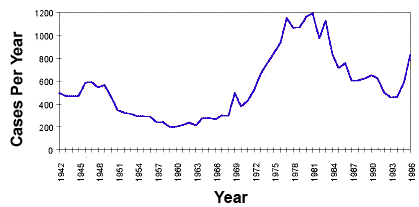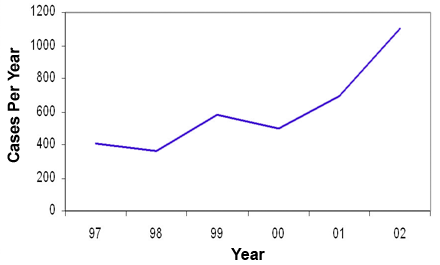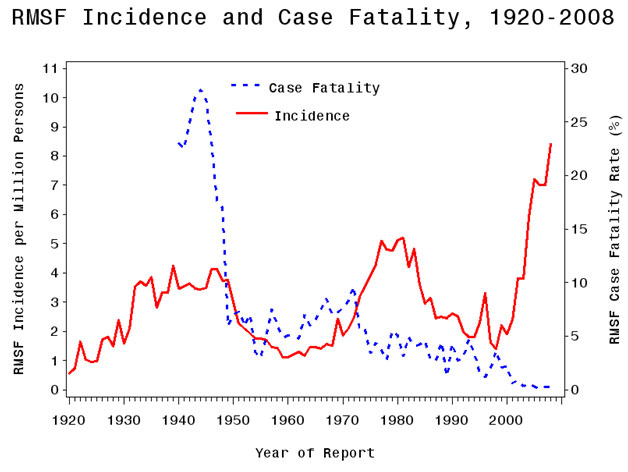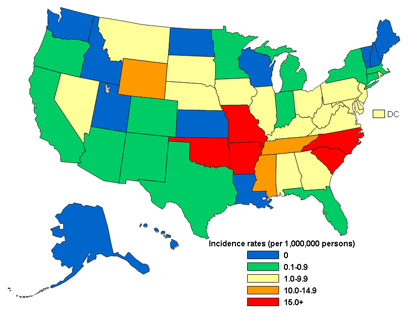Rocky Mountain spotted fever epidemiology and demographics: Difference between revisions
No edit summary |
|||
| Line 21: | Line 21: | ||
Over 90% of patients with Rocky Mountain spotted fever are infected during April through September. This period is the season for increased numbers of adult and nymphal Dermacentor ticks. A history of tick bite or exposure to tick-infested habitats is reported in approximately 60% of all cases of Rocky Mountain spotted fever. | Over 90% of patients with Rocky Mountain spotted fever are infected during April through September. This period is the season for increased numbers of adult and nymphal Dermacentor ticks. A history of tick bite or exposure to tick-infested habitats is reported in approximately 60% of all cases of Rocky Mountain spotted fever. | ||
[[Image: | [[Image:RMSF seasonality.jpg|center|500px]] | ||
'''Geography of Rocky Mountain Spotted Fever''' | '''Geography of Rocky Mountain Spotted Fever''' | ||
Revision as of 18:48, 14 February 2012
|
Rocky Mountain spotted fever Microchapters |
|
Differentiating Rocky Mountain spotted fever from other Diseases |
|---|
|
Diagnosis |
|
Treatment |
|
Case Studies |
|
Rocky Mountain spotted fever epidemiology and demographics On the Web |
|
American Roentgen Ray Society Images of Rocky Mountain spotted fever epidemiology and demographics |
|
FDA on Rocky Mountain spotted fever epidemiology and demographics |
|
CDC on Rocky Mountain spotted fever epidemiology and demographics |
|
Rocky Mountain spotted fever epidemiology and demographics in the news |
|
Blogs on Rocky Mountain spotted fever epidemiology and demographics |
|
Directions to Hospitals Treating Rocky Mountain spotted fever |
|
Risk calculators and risk factors for Rocky Mountain spotted fever epidemiology and demographics |
Editor-In-Chief: C. Michael Gibson, M.S., M.D. [1]
Overview
Epidemiology
Rocky Mountain spotted fever has been a reportable disease in the United States since the 1920s. In the last 50 years, approximately 250-1200 cases of Rocky Mountain spotted fever have been reported annually, although it is likely that many more cases go unreported. CDC compiles the number of cases reported by the state health departments. To ensure standardization of reporting across the country, CDC advises that a consistent case definition be used by all states.




Seasonal Distribution of Rocky Mountain Spotted Fever
Over 90% of patients with Rocky Mountain spotted fever are infected during April through September. This period is the season for increased numbers of adult and nymphal Dermacentor ticks. A history of tick bite or exposure to tick-infested habitats is reported in approximately 60% of all cases of Rocky Mountain spotted fever.

Geography of Rocky Mountain Spotted Fever
Over half of Rocky Mountain spotted fever infections are reported from the south-Atlantic region of the United States (Delaware, Maryland, Washington D.C., Virginia, West Virginia, North Carolina, South Carolina, Georgia, and Florida). Infection also occurs in other parts of the United States, namely the Pacific region (Washington, Oregon, and California) and west south-central (Arkansas, Louisiana, Oklahoma, and Texas) region.
The states with the highest incidences of Rocky Mountain spotted fever are North Carolina and Oklahoma; these two states combined accounted for 35% of the total number of U.S. cases reported to CDC during 1993 through 1996. Although Rocky Mountain spotted fever was first identified in the Rocky Mountain states, less than 3% of the U.S. cases were reported from that area during the same interval (1993-1996).

Worldwide Infection
Infection with Rickettsia rickettsii has also been documented in Argentina, Brazil, Colombia, Costa Rica, Mexico, and Panama. Some synonyms for Rocky Mountain spotted fever in other countries include tick typhus, Tobia fever (Colombia), São Paulo fever and fiebre maculosa (Brazil), and fiebre manchada (Mexico). Closely related organisms cause other types of spotted fevers in other parts of the world.

Demographics
The frequency of reported cases of Rocky Mountain spotted fever is highest among males, Caucasians, and children. Two-thirds of the Rocky Mountain spotted fever cases occur in children under the age of 15 years, with the peak age being 5 to 9 years old. Individuals with frequent exposure to dogs and who reside near wooded areas or areas with high grass may also be at increased risk of infection.
Infection with Rickettsia rickettsii has also been documented in Argentina, Brazil, Colombia, Costa Rica, Mexico, and Panama. Closely related organisms cause other types of spotted fevers in other parts of the world.